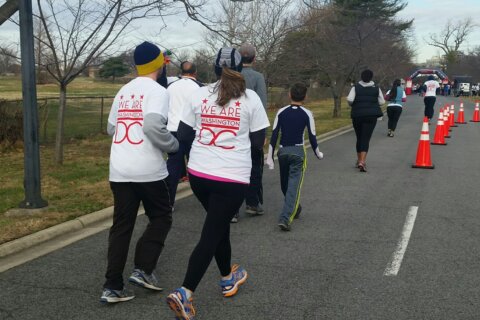
In a statement released Saturday, the U.S. Secret Service admitted to using pepper spray to disperse the crowd of protesters at the north side of Lafayette Square on June 1.
The Secret Service initially declined to reveal whether its officers had used sprays, rubber bullets or pepper balls ahead of the 7 p.m. curfew in the District that night. The engagement between police — including the U.S. Park Police and police from Arlington County, among others — has been widely covered.
Shortly after the crowd had been pushed back from 16th Street NW toward Connecticut Avenue, President Donald Trump walked the length of the square from the White House to take photos with the Bible in front of St. John’s Episcopal Church.
Many members of the media, including WTOP reporter Alejandro Alvarez, reported tear-inducing gas in the air after officers engaged protesters along H Street.
The back-and-forth between reporters, the Park Police, and others began a week-long discussion about the difference between tear gas and pepper spray.
Eventually, a Park Police spokesman agreed that there was only a minor difference between tear-inducing crowd control tools like pepper balls and tear gas, and that it was confusing to assert that “tear gas” had not been used.
The Secret Service on June 13 walked back a statement from a week earlier that none of its officers used pepper spray on the crowd.
In the statement, the agency said “the employee utilized oleoresin capsicum spray, or pepper spray, in response to an assaultive individual.”
Secret Service Statement: pic.twitter.com/hsocyFntAl
— U.S. Secret Service (@SecretService) June 13, 2020
U.S. Park Police confirm using smoke canisters, stinger balls use
The U.S. Park Police said in a press release its officers used pepper balls, stinger balls and smoke canisters during the June 1 protest, as they responded to protesters becoming “more combative” before D.C.’s 7 p.m. curfew.
Acting Chief Gregory T. Monahan said protesters were to be moved to H Street, so the installation of the new temporary fencing around the White House could begin. With 30 minutes before the start of the curfew and officers giving out three warnings on a loudspeaker to the protesters, the clearing began.
“As many of the protesters became more combative, continued to throw projectiles, grab officer’s protective equipment, and even attempted to grab one officers’ weapon, officers then employed the use of smoke canisters, stinger balls, and pepper balls,” Monahan said.
Agencies operating under the command of the U.S. Park Police did not use tear gas to close the area at Lafayette Park, Monahan said.
The Park Police said the clearing happened not because of President Trump’s plan to walk to the church, but because it was only at this time that there were “enough resources on the scene” to start placing the temporary fencing, Monahan said.
In the days leading to the installation of the fence, more than 50 Park Police officers were injured in conformations with protesters.
“The amount of injuries dramatically decreased beginning June 2, 2020, throughout the rest of the week,” Monahan said. “It also allowed for time, space and manner for those who wished to peacefully demonstrate.”
The events in the half-hour period leading up to the 7 p.m. curfew in D.C. continues to be a topic of discussion. The District’s nonvoting representative in Congress, Eleanor Holmes Norton, released an account of a conversation she had with a member of the D.C. National Guard, who said the crowd was too large for the warning announcements to be heard.
The Park Police has not responded to questions sent by WTOP on June 5 regarding the actions committed during the June 1 protests.







